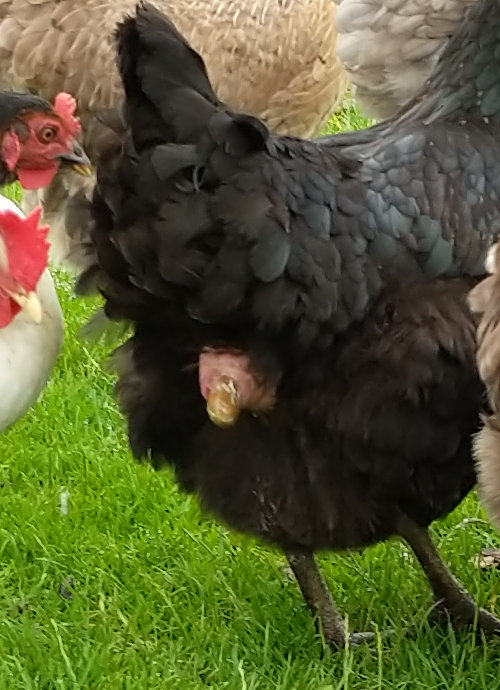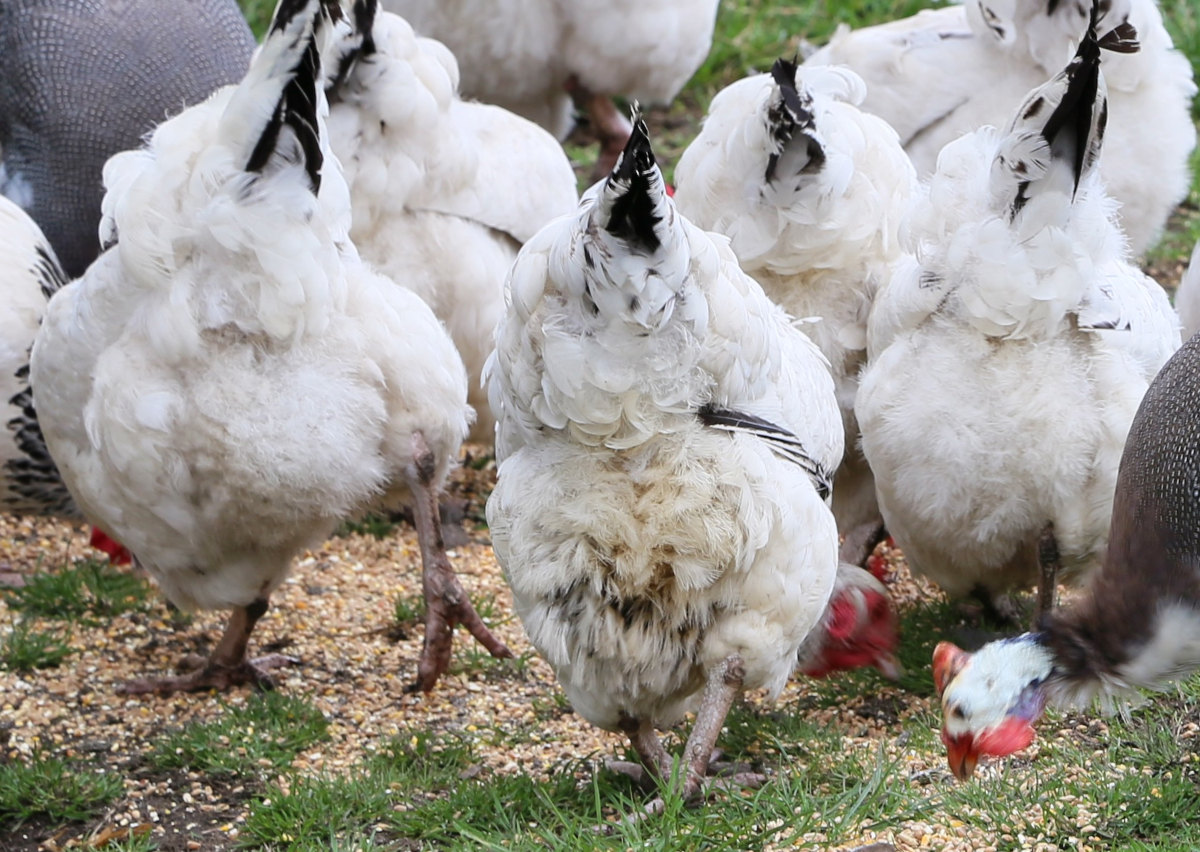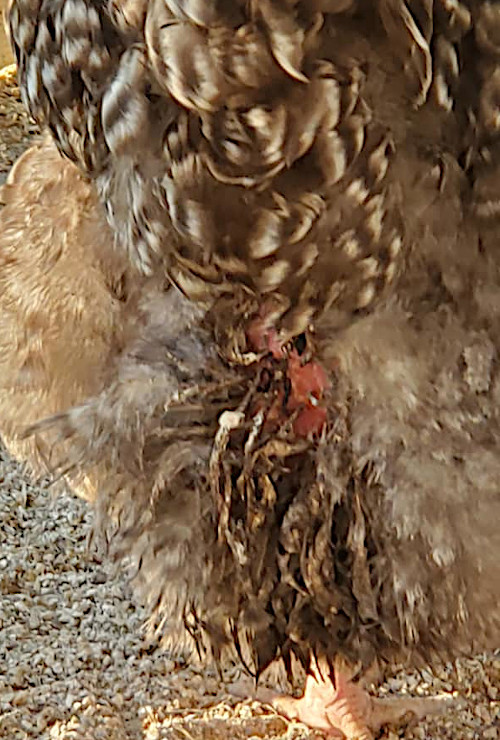Why do my chickens have dirty bottoms

Most keepers will find a chickens that has a dirty or messy bottom from time to time.
Many years ago, my chicken keeping mentor, who was a brash Yorkshire farmer, used to call it "Shitty Knickers" which was quite descriptive but not really much help when it came to diagnosing the problem.
Table of Contents
- Why does my chicken have a dirty bottom?
- What should a normal chickens bottom look like?
- What is wrong with my chickens bottom?
- Is it normal for chickens to have poop on their feathers?
- These are a few things I have learned over the years to cause dirty bottoms in chickens:
- Treatments for dirty bottoms in chickens:
- Should I wash my chickens bum or clip the feathers?
- Do some breeds suffer more from dirty bottom feathers than others?
- How do you treat cloacitis or vent gleet in chickens?
- Can cloacitis or vent gleet kill a chicken?
Why does my chicken have a dirty bottom?
Dirty bottoms on your chickens mean that there is either an infection or a digestive problem going on and that your chickens have diarrhoea or a discharge that is getting matted into the feathers.
There are a few reasons why chickens might have dirty bottoms:
- Diet: Chickens need a balanced diet that includes protein, carbohydrates, fats, vitamins, and minerals. If their diet is not nutritious enough, or if it is too high in carbohydrates, it can lead to diarrhoea.
- Parasites: Chickens can get parasites like worms and coccidia, which can also cause diarrhoea.
- Illness: Some illnesses, such as vent gleet and avian influenza, can also cause chickens to have dirty bottoms.
- Stress: Chickens can also get dirty bottoms if they are stressed. Stress can be caused by a number of things, such as overcrowding, loud noises, or predators.
- Feather type: Some breeds of chickens have more fluffy feathers around their vents than others. This can make it easier for manure to get stuck and accumulate.
Diarrhoea in chickens is second only to respiratory disease as the most common causes of illness in chickens.
It may also have a completely innocent explanation, like they sat in a muddy puddle. You will need to get up close and personal with the chickens in question and a good pair of rubber gloves may help.
What should a normal chickens bottom look like?
A normal healthy chickens bottom should have a puff of clean feathers with no discharge from the vent, staining or poop stuck in the feathers.
Below: A healthy chickens bottom showing a big cushion of clean vent feathers.

It is normal for chicken vents to pulse and will move occasionally.
Below: Here is a normal chicken bottom working just as it should.

You can see how the whole vent pushes outwards and at the same time the feathers pull away to leave a clear path for normal operations. This pulsating motion keep the poop clear of the feathers.
What is wrong with my chickens bottom?
A dirty bottom or discharge from the vent means that you chicken is unwell and the problems that manifest around the vent and in the feathers on the bottom normally start a little higher up the digestive system.
Some dirty bottoms will clear up on their own in a few days, some cases will take some routine or dietary adjustment and a couple of the causes of messy bottoms in chickens require veterinary treatment.
The reality is that when you see a dirty bottom in chickens it is normally a symptom of a different problem.
Is it normal for chickens to have poop on their feathers?
It is not normal for a chicken to have poop on it's feathers. It may happen occasionally and once or twice is nothing to worry about but a chicken with a permanently dirty bottom has something wrong with it.
Chickens poop and lay eggs out of the same hole or vent, called the cloaca. There is some nifty biology in there that normally stops both processes happening at the same time but not always.
Below: Sometimes vent feathers can be a little dirty and it is not a problem.

It could also be quite normal for a light coloured chicken to have some discolouration of the feathers around the bottom without there being a problem.
The real problem is wet or smelly feathers around the vent.
These are a few things I have learned over the years to cause dirty bottoms in chickens:
- Lettuce. The sweet iceberg types are the worst but even baby leaf and baby spinach.
- Toxic or laxative plants. Some plants like buttercup and kingcup (there may be others) can be a real problem in the fall as they are often the last bright green leaves on the ground.
- Too much fibre in the diet - I have seen this happen with things like sunflower seeds fed shell on. In chickens fibre is digested in a pair of organs called the cecae attached toward the end of the intestines. When these pouches are emptied it results in a liquid brown poop that is more likely to stick to the feathers.
- Excessive protein.
- High salt levels in the diet. I had this after my hens got into the pig feed which has quite high salt levels.
- Mouldy feed - Mycotoxins can cause all sorts of problems and dirty bottoms is one of them.
- Heat stress causes chickens to drink much more water.
- High carbohydrate levels. Overfeeding whole grains, particularly barley, and split maize.
- Sleeping on the floor. Chickens void all night and it will mess the feathers. Chickens should roost.
- Too many milk products, cheese or yogurt in the diet. Chickens lack the digestive enzymes necessary to properly digest milk products.
- Certain fruits like the elderberry.
- A candida or yeast infection sometimes called cloacitis or vent gleet. Has a unique smell and discharge.
- A bacterial or viral infection.
- It can be an early sign of coccidiosis.
- Certain breeds are prone to it. Pekins and Orpingtons have a bigger bustle of feathers at the rear and are more easily affected.
- Birds that are not yet in lay getting layers ration. The surplus calcium in layer feed can be too much for the rather leisurely pace at which breeds like Pekins lay eggs.
Treatments for dirty bottoms in chickens:
The first treatment for dirty bottoms in chickens is an elimination diet with no treats to make sure they are only eating their pelleted feed.
You should also treat for coccidiosis as this is a quick easy win if it is the problem.
If you notice that one or more of your chickens has a dirty bottom, there are a few things you can do:
- Check their diet: Make sure they are getting a balanced diet that is appropriate for their age and breed.
- Deworm your chickens: It is a good idea to deworm your chickens regularly to prevent parasites.
- Treat for coccidiosis: This is a common problem that is easy to treat.
- Isolate any sick chickens: If you think a chicken is sick, isolate it from the rest of the flock to prevent the spread of disease.
- Reduce stress: Try to identify and eliminate any sources of stress in your chicken coop.
- Trim the feathers around their vent: If your chicken has a lot of fluffy feathers around their vent, you can trim them carefully to make it easier for manure to fall off.
- Check your land for poisons: Some plants are toxic and can cause dirty vent feathers.
- Treat for vent gleet: An infection of the cloaca with a strong smelling sticky discharge leading to crusty vent feathers.
If you are using any home remedies, it is important to monitor your chicken closely and see if there is any improvement. If the vent gleet does not improve after a few days, or if it gets worse, you should consult with a veterinarian.
That will just leave infections and your vet will tell you if it is viral, bacterial or a yeast infection called vent gleet.
A chicken with a dirty bottom that is not laying eggs will need treatment quickly.
Should I wash my chickens bum or clip the feathers?
You should do both. Use a sturdy pair of scissors to remove the worst few feathers around the vent and then wash your chickens bottom.
You clean the dirty bottom chicken with some baby shampoo or dog shampoo and warm water at 40C (100F).
Below: Clip the dirty feathers and wash the bum.

You should use gloves and it is easier with two people. Stand the chicken in a bowl of warm soapy water and wash the bum till the feathers are clean. Rinse with clean warm water and keep the hen inside until she is dry.
Clipping the feathers will lessen the chance of it happening again and let you see the vent more clearly.
Do some breeds suffer more from dirty bottom feathers than others?
Yes, some chickens breeds suffer dirty bottoms more than others. Commercial hybrids do not take well to feeds other than pellets and the habit of re-homing rescued battery hens makes this a common problem as the hens are already weakened.
Very feathery breeds like Pekins, Silkies and Orpingtons have more feathering around the vent and this can be an issue.
How do you treat cloacitis or vent gleet in chickens?
Cloacitis or vent gleet is the inflammation of the cloaca or vent and is a symptom of other health problems in the chicken.
It has many causes and can be transmitted between birds. It is linked to viruses, bacterial infections, treatment with antibiotics and cloacal injury.
Here are some specific home remedies that may be helpful for treating vent gleet in chickens:
- Epsom salt bath: Soak the chicken in a shallow bath of warm water mixed with two tablespoons of Epsom salts for 10 minutes. This can help to soothe the irritated skin and promote healing.
- Apple cider vinegar: Add a tablespoon of apple cider vinegar to the chicken's drinking water. This can help to balance the pH of the digestive system and create an environment that is less conducive to bacterial and fungal growth.
- Probiotics: Add a probiotic supplement to the chicken's food or water. This can help to restore the balance of good bacteria in the digestive system and fight off infection.
Can cloacitis or vent gleet kill a chicken?
Vent gleet, also called cloacitis is a yeast infection and is a clear sign that your chicken is unhealthy and needs care and treatment. If left untreated vent gleet will eventually kill chickens and may spread to the rest of the flock as well.
